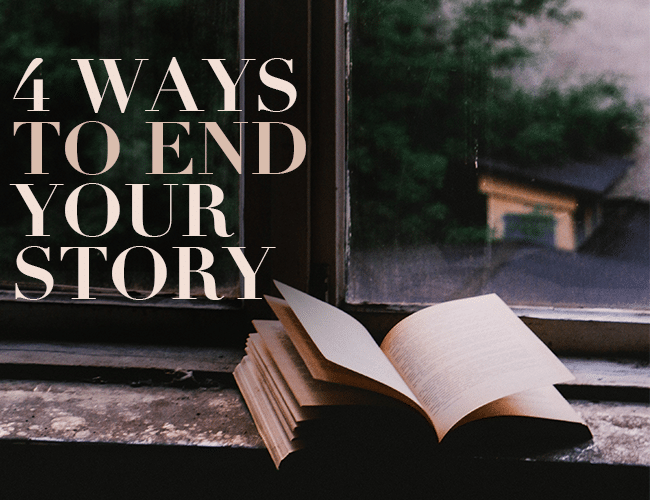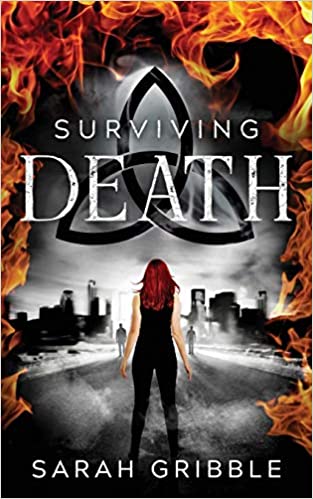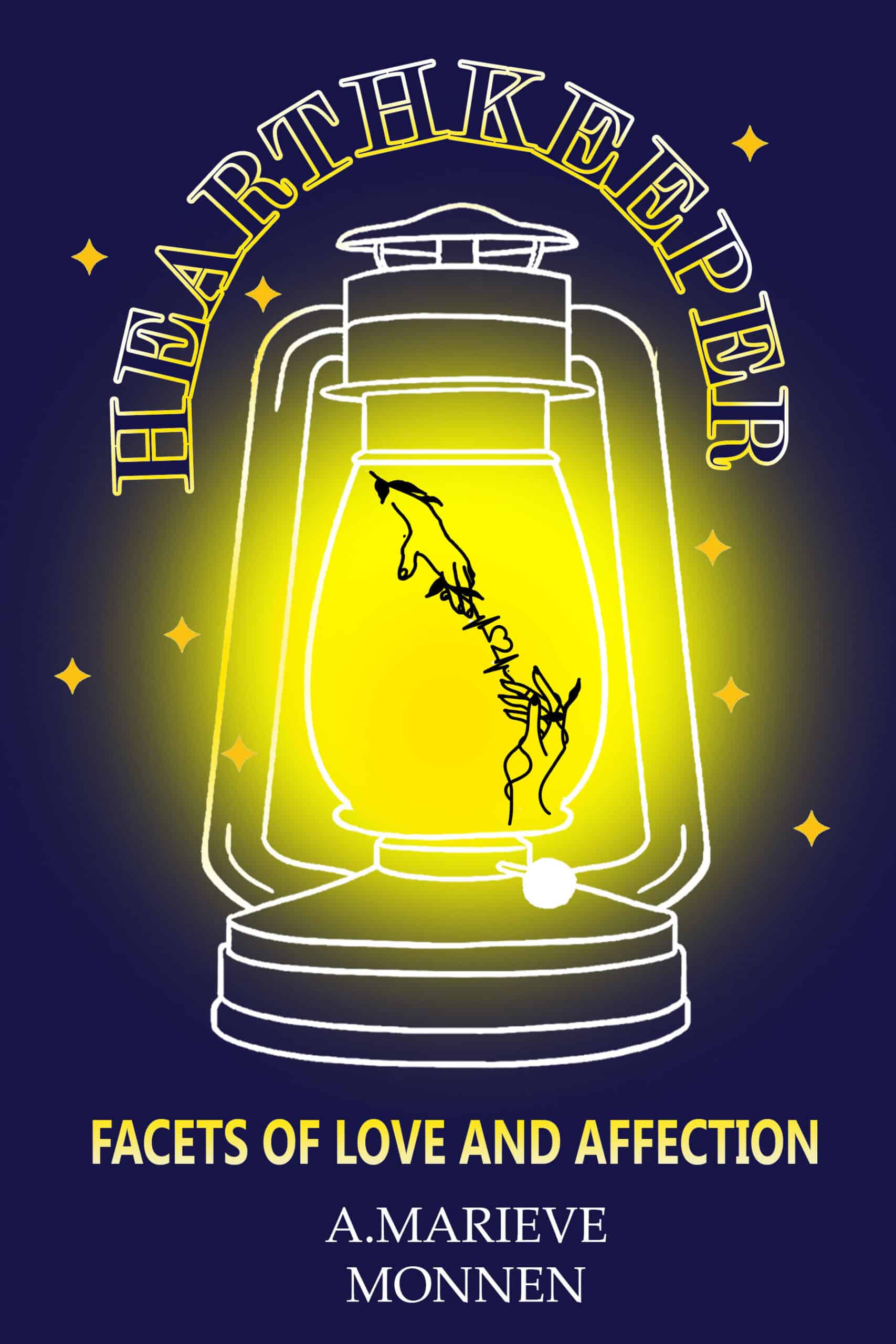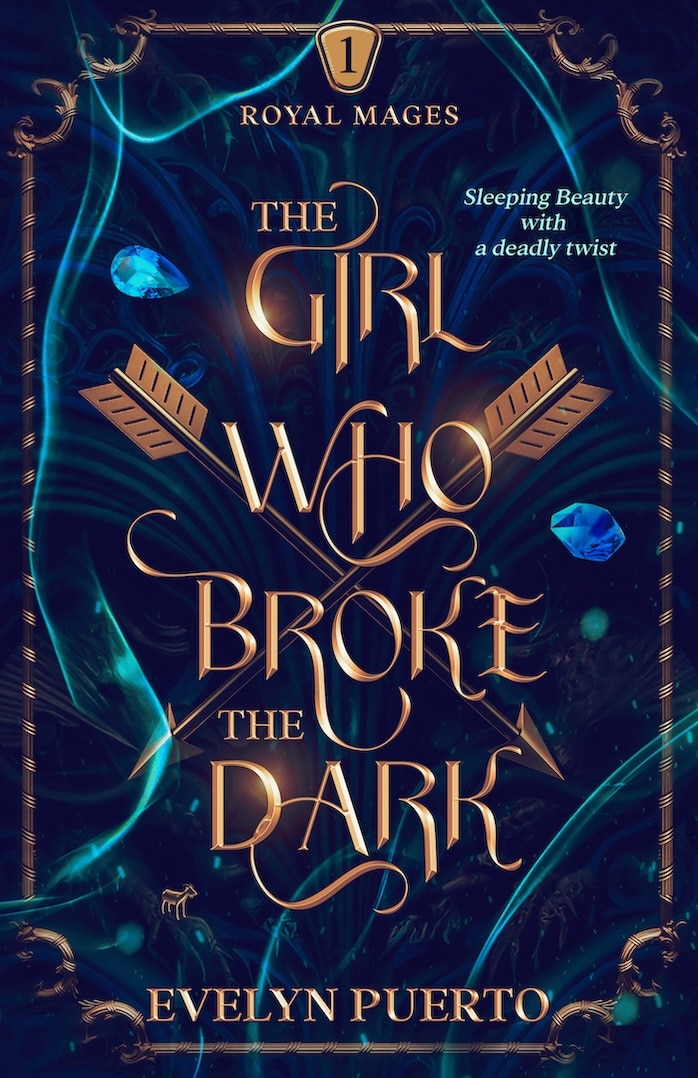Endings are hard. Nobody likes to say goodbye, and saying goodbye in a story is especially hard. The pressure is on to get that last part just right and determine how to end a story well.

When there are so many possibilities for a conclusion, how do you know which one is right for your story?
4 Classic Possibilities for How to End a Story
Before you can choose an ending, you need to figure out what your choices are. Here are a few basic ones to get you started.
1. The “happily ever after” ending
The classic, feel-good ending. Disney is the master at this. Every character meets their goals (except for the villain, of course), the romantic couple gets together (they might even get married), and you finish the story feeling like you can accomplish anything.
This sort of ending goes along best with fairytales and most children’s stories. That’s not to say stories for adults can’t have this kind of ending, too, but it works to perfection when the story already has a light and happy quality to it. You don’t want to write a depressing plot only to wrap it all up in the last chapter. It’ll throw off your reader and make the conclusion seem far-fetched.
2. The tragic ending
The protagonist’s main goal doesn’t go as planned, curveballs are thrown, and tragedy strikes. These are tricky to write, because there’s a fine line between writing a tragic, artistic ending and a conclusion that will leave your reader in a hopeless slump.
If you’re planning on having an unhappy ending, you’ll need to foreshadow that throughout the story. Have a slightly gloomy, ominous tone from the very beginning. Your reader might not expect it, exactly, but it won’t come as a total shock, making it an easier ending to swallow.
But, remember to have some bright moments, little nuggets of happiness the reader can hang onto after the story is finished.
3. The ambiguous ending
This isn’t everyone’s cup of tea, but it’s one of my favorites. The ambiguous ending goes well with an “indie” story. A simple plot—usually something contemporary, but not necessarily—works best, because it focuses most on the characters, leaving a lot up to the reader’s imagination when it comes to what happens after the story is finished.
If you do decide to go with this ending, remember that there’s a huge difference between ambiguity and unfinished business. If you drop the plot too suddenly, the reader wonders if there are pages missing from the end of the book, if something’s gone wrong. What you want to do is drop enough hints that someone can come close to determining what will happen, but they’ll never know for sure.
4. The bittersweet ending
Sometimes this can even pair with the ambiguous ending, but it doesn’t have to. This conclusion might look like the protagonist failing to meet their goal, but finding something else along the way. Maybe the main couple doesn’t get together, but they’ve found happiness apart from each other.
Make the ending unexpected, but hopeful. The reader will be pleasantly surprised and leave the story with a sense of calm and satisfaction.
End Your Story Well
Maybe you knew how your story would end when you started writing it. Maybe you're on the next-to-last page and you still don't know. Whatever the case, these four options for how to end a story can get your imagination flowing. How will your story end?
What’s your favorite ending in a story? Why do you like it? Let us know in the comments.
PRACTICE
Choose an ending from above that’s out of your comfort zone. Maybe it’s not your favorite or you’ve never written it before. Now, here's your story prompt:
The lizard was enormous, at least three feet long. It also wasn't in its tank.
Write the conclusion before you write anything else. Write for fifteen minutes. When you’re done, if you’d like, share your ending in the comments. Be sure to give your fellow writers some feedback, too. Have fun!
The Magic Violinist is a young author who writes mostly fantasy stories. She loves to play with her dog and spend time with her family. Oh, and she's homeschooled. You can visit her blog at themagicviolinist.blogspot.com. You can also follow The Magic Violinist on Twitter (@Magic_Violinist).



What I have planed for one of my stories is the hero has a grad battle with the villain, while trying to get through them. But the villain “dies” and the hero is left wondering if their words had made a positive impact. Days later, the hero has trouble with a lesser villain (the battle with main villain has made an impact) but before the lesser villain can land a fatal blow, the villain who died comes to the rescue (very much injured, and with a missing arm and eye) and the good person they were once before.
My ending(?)
__________
The files were gone but the memories were fresh.
The office was dark, shying away from the light of the open door. Bruna gazed at the cleaned up room, as though there had never been any chief detective.
She ignored the light switch as she strolled into the office, heels clicking against the tiled floor.
He was still here.
Here, where the scent of cigarettes and cheap cologne with fancy names clinged to the furniture. Where the walls were prickled with old tacks and tape.
He was with her. His detached voice ringed in her ears and shadowy eyes still piercing her.
He was here. Alive. Puzzled but questioning. Seeking. Discovering.
Even while his body laid cold.
_______________
Very good.
Now THAT was clever! Closure never felt so good!
In both my books, Zombie Turkeys and My Undead Mother-in-law, I seemingly end happily, and then throw in an ambiguous twist.
Here’s part of the end of my WIP:
Smoke and dust filled the air with the crackle of flames. Lucas’s wild cackling cut across the roar of Angriz as he breathed fire at a pack of orcs. A gust of wind cut through the swirling maelstrom of the battlefield.
“Haven’t you figured it out yet, Dearbhaile? You can’t touch me.” The corpulent man chortled.
“Nae, but Ah can distract ye.”
“Huh?”
A mace, the head glowing with a yellow tinge exploded through his skull, sending bloody bone fragments in a wide spray. “I touched you, mother fucker.” Adora’s triumphant voice was cold.
The body of Lucas Rumpff collapsed with an odd purring sound. The women looked on, puzzled as it slowly faded from view.
“What the hells?”
“I didnae know, Adora.” The half-elf Keeper stepped closer. “I had nae inkling anything like this would happen.”
The Queen knelt and touched the ground where the body had been. “Where did his body go?”
A familiar bark of laughter brought both women around, hands raised defensively. Adora’s mace flared with the yellow light of holy fire and Dearbhaile’s hands were wreathed in red with black flames jumping and flickering.
Adora’s jaw dropped as she stared, incredulous, at the familiar, large, white-clad form of the Wizard they knew as Mordecai.
“What’s wrong, ladies? Never seen an illusion fade before your eyes?” Lucas threw his head back, roaring with laughter. “Oh, if only you could see your faces right now.” His kissed his fingertips. “Priceless.” The last was said with an exaggerated hoarseness.
A blue-colored crystalline blade flashed across his neck and nearly embedded itself in the wall. As the brown haired head of the Wizard toppled forward and then rolled down the body, blood fountaining into the air, Robilar stepped from the shadows.
“As priceless as that?” A sharp yank pulled the sword free of the wall with a shower of stone fragments. He looked at his friends. “Wizards never seem to know what to do with Chronomancers. They’re always running out of time.” He stepped down to the women. “Are you okay?”
As they nodded, hands clapped behind him. “Oh, that was just perfect timing with that pun!”
Robilar spun, sword angled diagonally across his chest. He gaped as the headless body sat up and then rose to its feet. A head grew from the stump of the bloody neck.
Lucas shook his newly grown head hard. “Jeeze, don’t you know how much that stings?” He looked back and forth at the trio. “Men in Black?” They didn’t move. “Nothing? Sheesh.” He tugged his collar to the side. “Tough crowd.”
The unfinished business ending. What does that mean exactly? Imminent danger is over for the moment but there may be more coming in the future. I’m talking specifically when writing in the mystery/crime/thriller genre. The problem isn’t 100% solved but the protag can catch their breath, live their life (for now) and hopefully extricate themselves completely somewhere down the line. And it may be a satisfying enough ending for your readers but leave the door open in case you want to do another book.
Did you accidentally reply to the wrong person? Or, were you referring to my saying it is part of the ending?
Yes. Sorry. I meant to ask a question to the group.
That’s okay.
i am not sure how to end mine yet, Chris hasn’t decided what to do with his problem
I almost have to have a happy ending, since I write for small children, but sometimes I can’t figure out which ending to use.
Checking email tonight and saw the “How to End a Story” subject line in today’s Write Practice—a funny coincidence because my eleven year-old grandson was giving me advice on the same subject just this afternoon.
I’m writing stories for my grandchildren. While each child doesn’t know anything about the story I’m writing specifically for them, I do use the siblings and cousins as “mini” beta readers to get some kids’ feedback (they are all avid readers, so I trust them). I recently took a short-story course, and used one of these stories to work on for the class. Today I told my grandson about the class, and that while taking it I had finished one of the stories, but that I had had to quickly devise a new ending for it because I had a maximum word count. After agreeing to read the new version, he said, “Wanna know a fast way to end a story, Gram? Just have everyone die.”
Gram: “What?!”
Grandson: “You know. Like have everyone climb a mountain and after they get to the top, there’s an accident and they all fall off. If they were on a mountain and fell off, that would be realistic.”
Gram: “I’m not going to have your cousin die! I couldn’t write something like that.”
Grandson: “Why not? You’re just making it all up anyway.”
The past few months there have been many times when I’ve been stunned by how grown-up he’s becoming…and then there are times like today when I’m reminded of just how young he still is.
Advice from your grands? Priceless! Want to trade children’s stories. I am writing a middle grade mystery for a contest and my grandsons. The age group is 8-12, as you know. My critique groups are usually writing for the adult market. They say my precocious, book-reading ten year old girl does not talk like her age. Help. How can I get to the ending if the beginning is advised to be changed by my critics?? “I was a curious ten-year-old girl who wanted to know what all the adults around me knew. The year Nana came to live with us changed my life.” (The beginning of “Family Secrets”) One critique partner said the first line is too much “on the nose.” How do you hook the reader if you don’t have a great first line? Any comments about beginnings? And then I can focus on the middle and the end….
Tragic and Happy endings are my fave.
My fave endings are the happy and tragic endings.
The cell door opened. The broken wretch did not deign to raise his head. He resigned himself to yet another session of agony as the other advanced.
A moment passed, then he felt the other’s hands remove the sack from his head. The man lifted his head, his eyes widening in shock. Caedis realized this was no jailer.
The other studied his scarred face, so disfigured he was near unrecognizable. His gaunt frame bore lacerations and burns from long months of torture.
“Kill…me.” Caedis rasped, the effort awakening pain from many areas of his body.
The other retrieved a vial from within his garb. Removing the cork, he brought the green liquid to Caedis’ lips. “Rest, my lord.” he said, as Caedis drank, savoring each drop as if it were an elixir of the Fate’s making.
“Thank…you.” He said, a faint smile on his lips even as the poison did its work. The man turned and left, his heart heavy with sorrow.
Awwww, man. More pressure. Who knows how to end a story? And, the beginning? Middle?
Bittersweet endings are my favorites, because most of the time they are unexpected. Ambiguous are very tricky, not everyone can do it in a satisfactory manner. It’s frustrating when you, as a reader, are expecting something more and the story suddenly ends with no explanations.
The lizard was enormous, at least three feet long. But it was also not in it’s tank.I grabbed Fomi’s hand firmly. “We’re in trouble”, he said in his shrill tone “Crocodile,crocodile”-outside,the children were screaming. We rushed outside through the other door and there it was,seemingly in hot pursuit of the children.It was useless trying to call them back.We stood petrified as they rushed towards the highway.The sound of screeching broke through the air.Fortunately, no one was hurt.We had nurtured this monitor lizard for months. Principal had warned us.”Don’t let that fellow grow too big before you dissect it.” Now he wore a much sterner look.”Who left the door open? “Fomi and I glanced at each other. “We have questions to answer at the police station”, he motioned to the waiting car.
Nice post! I tried my hand at the practice, but it seems I got a bit carried away. I’ll post it all the same. I wanted to attempt a happy ending, but it turned ambiguous instead, oops.
_________
The lizard was enormous, at least three feet long. It also wasn’t in its tank.
Lisa looked down at the paperweight, as if surprised to find it in her hands. Like an onyx cat would make a big difference in front of that monster. She was quivering from head to toe, but worse yet, she had no idea on what to do. The thing was just a couple of feet away, and the door had slammed shut behind her. By the time she ran to it and typed the code, it would be too late.
She started backing off as fast as she dared, which really was creeping speed. TV shows about crocodiles, alligators and similar unpleasantness flashed across her mind. Lisa did her best to push away the unchecked information, not daring to trust it without further research. It was silly, perhaps, but she had been raised this way, and she had worked this way for years. Always double-check facts no matter the context. Do not assume anything.
A crazy idea came to her. The craziest, no doubt, she had ever had. It was based on nothing except maybe hope, but she might as well try, since the situation could hardly get any worse.
“Don’t come close,” she said, her voice quavering.
“Let me out,” the lizard said in a hiss that was pitched painfully high.
Stunned, Lisa nearly dropped the paperweight.
“You can talk,” the animal said in surprise.
“I should be saying this,” the human protested.
Then it hit her; the tank had been sound isolated. She considered the bright purple lizard, its hair-thin tail and the single, curled antenna between the amber eyes.
“You’re not from…” It was difficult to say. “You’re not from Earth, are you?”
“Most definitely not.” It had a British accent. She wasn’t imagining it, was she?
“Do you mean any harm to us?”
Suddenly Lisa was more than a researcher; more than a chemist, more than a human. She was an ambassador.
“No! All I want is to fly back home. I didn’t mean to crash here, precisely.”
She wanted to laugh, but wasn’t completely sure why. Could she let the lizard go? Was it telling the truth?
“Besides,” the lizard added, “if you try to bar my way, I’ll have to take you with me.”
There was a too-casual ring to this. What did space lizards eat?
“You may go.”
Luckily, she had managed to push the stutter out of her sentence before speaking, but she still sounded unsure. There was no other way, she told herself.
“Good.”
It walked in the awkward way large lizards do, feet flapping on the floor. Before Lisa knew it, it had climbed into the blue capsule and was muttering to itself, curiously in English, about the damage.
“Um… Can I help?” Lisa asked.
“No,” it said harshly. “Humans have helped enough.”
Its dry voice twisted around the words. Lisa felt guilty, even though she wasn’t the one who had given the orders. She tried to apologize, but only a squeak came out.
“Good. Just enough fuel to get back. Good.”
It looked back at Lisa with one of the two eyes, and the antenna tilted her way.
“This is goodbye, human. For now.”
And before Lisa could return the goodbye, exclaim an apology or demand clarification of the last two words, the capsule disappeared with no flash or fancy effect beyond a small popping noise.
My children’s stories have happing endings; novels are usually with a satisfactory ending, but the reader can draw his own conclusions for a scene beyond it; memoirs end with what actually took place, some are good and the one I’m editing at present has a tragic end, though not quite, because the reader has hope that it can be resolved with time.
The ending for my main project is somewhat bittersweet, but it’s also tragic. Most everyone gets a happy ending, but not everyone. That the ending won’t be super happy is foreshadowed at the climax, but I’ve known for a while. The story starts out light, mostly, with some dark tones from certain perspectives, but becomes a tale that is mostly dark with some light tones mixed in. The whole story is really rather bittersweet, because there is first excitement and dread for the coming events (inciting incident), then a long, slow fight towards the climax with mixed emotions, and then a mixed ending that is happy for most of the characters, mixed for a handful of others, and tragic for a few.
The ending also has elements of ambiguity, because the reader might never know how things turn out for the characters after the fact, depending on if I decide to someday write a second book.
My ending for The Man in the Moon
——–
The world was now in a harmonious state… The guy was dead, he left the world writhing in its horror, but at least he was dead, right? The world may be broken, but it wasn’t an oblivion just yet… It can still be fixed… Not, to be sappy or dramatic or anything, but my mind and heart wasn’t in peace. I wasn’t satisfied banishing the guy to an endless void of pain… No, I wasn’t delighted of it at all…
In the midst of the smoke, lay a body in a crater. A body that belonged to my brother… He was coughing blood, the air in his lungs seems to be stuck. He was choking, while coughing out blood. He was shaking too. I approached him, my grey eyes searching for a meaning; a meaning that was saying he could still live. I knelt by his side, a brandishing smile on my face, but it noticeably forced.
“Guess, I w-won’t be coming home, huh?” He coughed as he placed a hand on his heart, and his other on top of mine, “Please… Remove that ridiculous expression… You look like your the one dying, not me”
“I am dying-”
“Don’t even finish that…” He muttered, “Y
“I am so mad…”
“Why are you crying then?” Jill said looking at Ronnie sat on the couch blowing his nose.
He wadded the tissue and pointed to a large cardboard box.
Jill peeked inside with a gasp, and said, “I understand your sadness,” she clasped her hand to her heart as a wave of dizziness swept through her, “Yet your anger puzzles me.”
He punched the leather seat cushion and said, “I forgot to close the lid to tank after I fed him…I’m so stupid, I was in a hurry this morning…I left the sliding door to the balcony open as well.”
While a picture of Harry falling 8 stories to his death brought tears of agony, Jill grabbed the box of tissue and sat beside Ronnie to mourn their baby, who they had nurtured from the time he was 13 inches to his now 3 feet long.
My favourite endings are ones that let the reader imagine what comes next.I have just started writing and would be grateful for any advice or comments.
My two short stories are on my blog
https://unpublishedyet.wordpress.com
More on the way.Love the advice I receive here.